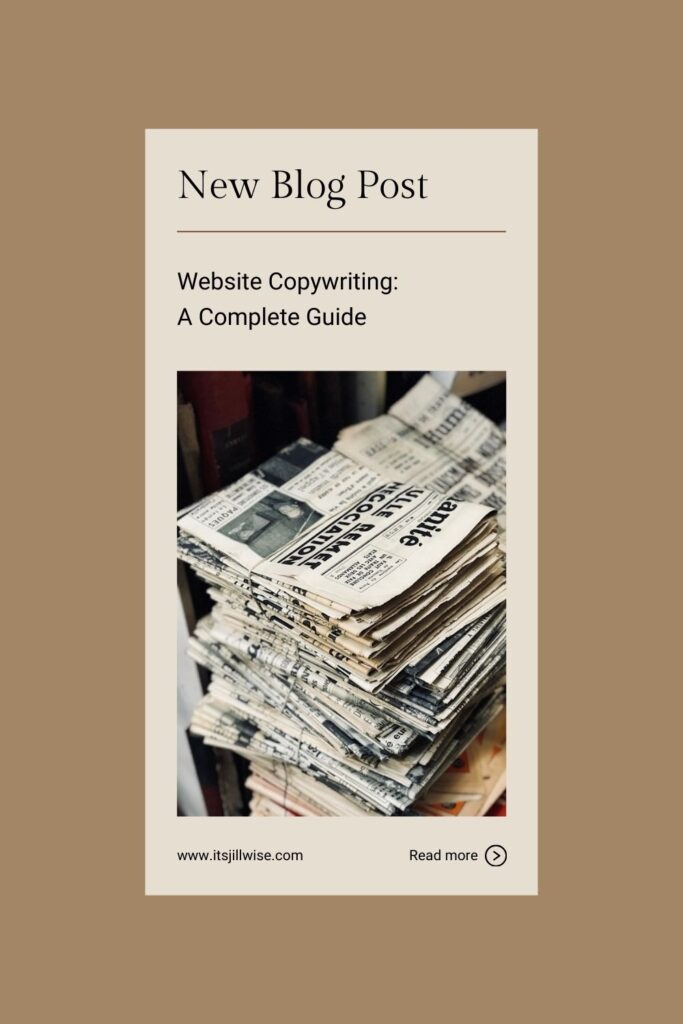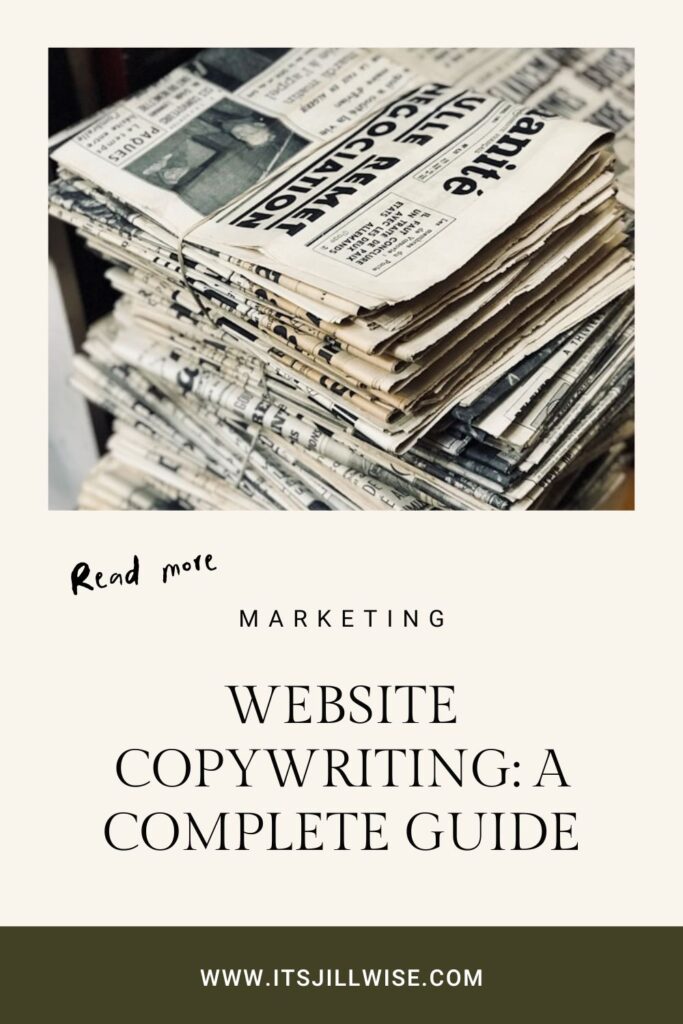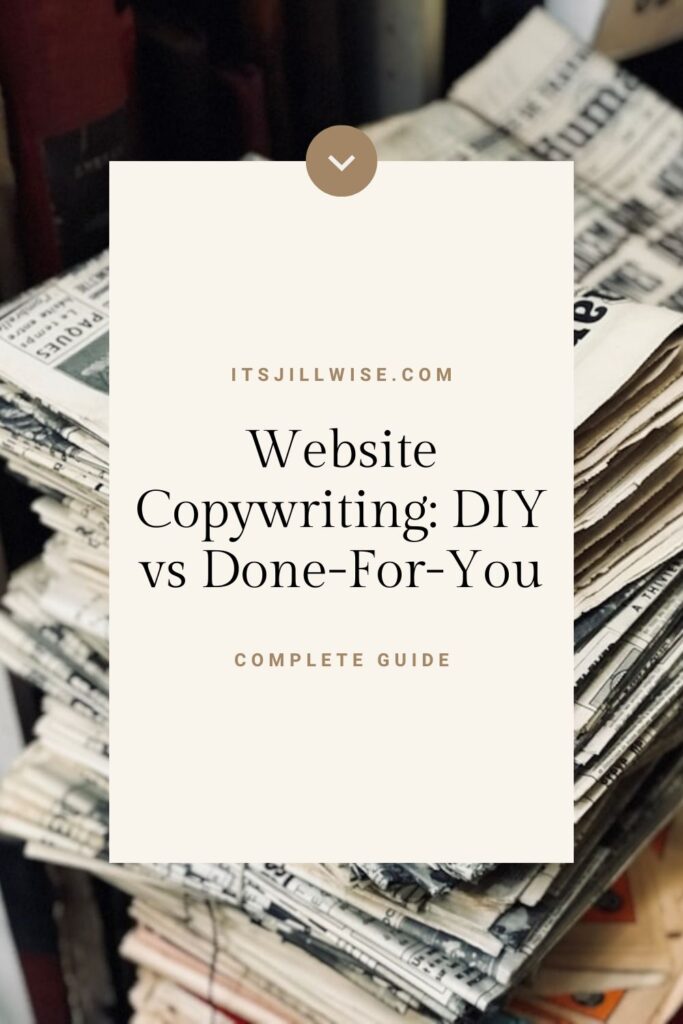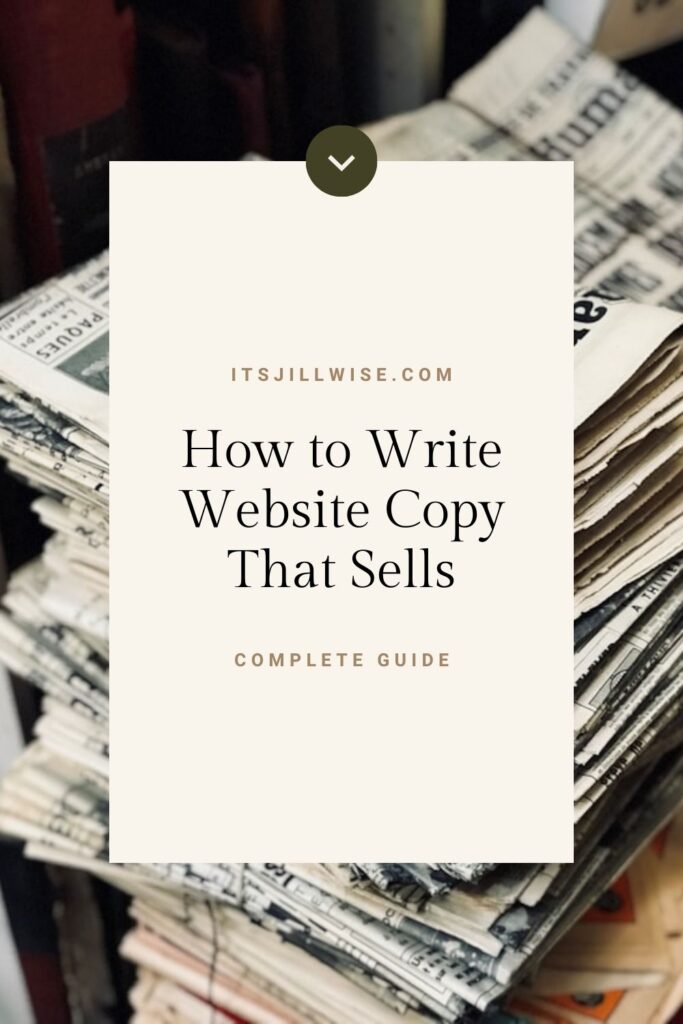How to write website copy
(and how to hire a website copywriter if you’re over DIYing)
No matter how great of a writer you are, it’s so hard to write your own website copy. Even with years of experience as a offering website copywriting services, and helping other brands and businesses learn how write website copy that sells their products and services, I still struggle to write my own sometimes. It’s hard to get out of your own head and write copy for yourself.
The good thing is that if you get this right and learn how to write website copy that sells from the beginning, your website should be able to grow with your business. I’m hesitant to say that your website copy should last you however many years because in reality, it’s more about your business’ growth than a specific measure of time. If your business stays the same for years, then your website copy probably can too. If your business grows at an exponential rate, then you might find that it’s broken and in need of a refresh to align with the current iteration of your business.
This has happened to me a few times before, and whenever I need to invest in a new website I know now that it’s just part of the growth process. When we move fast, we break things in the process. That’s okay. Actually, it’s a good thing.
Keep reading to learn how to write website copy that sells, including:
- What is website copy, really?
- What pages should you have on your website?
- Website copy rates if you plan to hire a copywriter.
- Actionable tips of how to write website copy that sells if you choose to DIY.
- What the heck are website copy templates and how do you use them?

What is website copy?
Let’s start here: What is website copy? When you’re new to business, you probably immediately thought I need a website so people can find me. After that, maybe you thought you should find a designer to create a logo for you. However, a fancy looking logo isn’t what you need to increase website conversions.
More on that later.
Most people don’t even consider the words on their website… That’s what website copy is.
Why website copywriting matters
To answer the question of why website copywriting matters, we first need to address the dilemma of copy versus content. People get this confused all the time, and understanding the difference will help you write with a clear intentions. The core differentiator is this: Content is meant to build relationships and drive traffic, while copy is carefully constructed to encourage action. That’s why copy is what converts readers into paying customers. It’s a sales tool.
Do you see why you’d rather have copy, not content, on your website?
When you look at website copy, or your website in general, you should approach it with the idea that your website is a lead generation tool. It’s up to you to guide the reader from Point A to B, considering the buying journey throughout the process. What do they need to think, believe, and feel about themselves and your business in order to get on your calendar or make a purchase? A logo alone can’t guide the reader in the same way as strategic copy.
Good website copywriting will weave together storytelling techniques and sales strategies, position your brand as the best option to solve a problem or fulfill a desire, and show the reader that you truly understand what they need. Even though it’s your business, your website copy shouldn’t be about you—it should be about the reader. It will also leverage your unique personality to better connect with your ideal clients, pulling the parts of your brand that will best resonate with them. Again, because it’s about them… Not you.
Strategic website copywriting increases conversions
Here’s my personal experience: For years, I was that freelance writer without a website… Yuck. When I transitioned to focus solely on copywriting, I created a website, but it was just a blog with a services page. After a while of telling clients “do what I say, not what I do,” I finally invested the time and resources in building my website from scratch. That included writing fresh copy for myself, just like I would a client.
The month after I launched my new website, I tripled my revenue. Seriously. How’s that for data? Many of my clients have seen similar results, including Hairstrong, who saw a 266% increase in conversions immediately after publishing her new website copy.
If that’s not reason enough to take your website seriously and finally set it up as a functioning step in your sales pipeline… I don’t know what is.
Your website is part of your sales pipeline
I grew my business to make over half a million dollars with solely inbound leads. How? With a high-converting, low-lift sales pipeline. That pipeline includes my website as a crucial step in the journey.
Your website copy should help leads pre-qualify themselves: It keeps the best fits clicking to your inquiry form or to purchase your product, and repels the rest. Good website copywriting is conversion focused, which means it combines key factors like:
- messaging strategy
- brand positioning
- brand personality
- your unique value
- voice of customer research
- direct-response copywriting techniques
- website copywriting best practices
- search engine optimization
- and more
This blog post breaks down the other must-have components of an inbound sales pipeline.
What pages do you need on your website?
There are a few pages that you absolutely need to have on your website. Without these, there’s no point in having a website at all.
- Home page to direct traffic through your website.
- About page to connect with your audience.
- Product pages, offer pages, or sales page to share your transformation promise.
- Contact to start the sales conversation.
- Blog to build authority and drive traffic.
This blog post breaks each website page down in more detail, including the importance of these core pages and how they increase conversions.

Website copywriting options: DIY, DWY, and DFY
Now that you know what website copy is and how it can be a powerful tool to drive sales, you might be debating: Do I write it myself? Or hire an expert? How much do website copywriting services cost?
Website copywriting services can range. Plenty of good copywriters offer entry-level packages to fit smaller budgets, just in a done-with-you format. Copywriting coaching, website copywriting audits, and website copy optimization offers all fall into this bucket.
There’s also many good website copywriting templates available. I have some ready for purchase in The Biz Bar.
And of course, there’s the option of custom website copywriting services: Hiring help to write website copy from start to finish. Investing in website copywriting is almost always a good idea. It’s literally my job as a website copywriter to make you more money.
Hire help for website copywriting services
A proven copywriter will run you anywhere from $4k and upwards for website copywriting. However, you need to consider this an investment, not an expense, because good copy puts money back in your pocket.
Website copywriting services are worth every penny—I’ve seen my clients level up in massive ways after investing in working with me. That’s because the above points around websites becoming lead generation tools for your business, rather than a glorified business card. It’s not about writing something pretty, but words that increase conversions. It’s more of a science than an art at first, with the creative flair added in at the end.
What are average rates for website copywriting services? Like anything, there’s a range. And you also get what you pay for. I’d say that the above $4k reference is a solid new writer. However, websites in general can cost upwards of $50k at the end of the day, so don’t look at that as law. For another example, at the time of writing this, my website copywriting services start at $4k for a simple website, after brand messaging strategy is complete. Simple is the key. The more complex the project, the higher the rate. I could raise that rate based on my experience, but in order to continue to work with the types of clients that I love, I keep it starting at this range.
While you can probably find less experienced copywriters with lower rates on freelancer platforms, I’d recommend not going that route. You will always have to get it redone by someone with proven results. To find a copywriter that you trust, ask your business community for recommendations, Google for website copywriters, or search on social media. Most of my clients find me on Instagram. I know other social platforms (like LinkedIn) are how my mastermind clients connect with their copywriting clients.
How to get the best ROI when hiring a website copywriter
If you’re considering hiring a website copywriter, you need to know how to get the best ROI from that relationship. How do you know you’re ready to outsource your website copywriting? And how do you find the best fit?
Not only do you want to pick someone who’s a proven website copywriter (duh), but you also probably want to actually like them. Big projects, like your website, are a lot easier if you align on your values and work styles. It makes for an easier collaboration.
Read more about how to choose a website copywriter here…

For done-with-you website copywriting services
Done-with-you website copywriting services are a great option if you are already a half decent writer, but need help optimizing for the web. A good website copywriter can help you improve your copy for conversions, brand personality, positioning, and more.
I offer an Intensive day reservation, and many clients who choose this option have website copy already. Either a draft, or something that’s already live on their website. We work together to improve this, speed dating style, so they don’t need to wait in line to get website copy updates.
Where to find a website copywriter
Hi 👋 it’s me. I’m a website copywriter, obviously!
If you don’t vibe with my style though (no offense taken), you can look for a website copywriter in other places where us word nerds hang out.
- Threads
- YouTube
Lots of us website copywriters make content on these channels, and for our own blogs and email lists. Check out a few website copywriters, and reach out to those who you vibe with.
For DIY: How to write website copy that sells
The big question if you choose to DIY your website copy: How do you write website copy that sells? A lot goes into writing website copy that converts. I personally have knowledge, personal, and professional experience in multiple areas that contribute to the overall success of a website:
- Writing
- Language and literature
- Popular culture
- Storytelling
- Sales
- Marketing
- UX
- Client experience
- Psychology, specifically around decision making
- Business operations
- Pricing
- Researching
- Grammar
- Online business trends
- And so much more…
Writing itself is just one piece of the puzzle. This is why it’s not only important to be a strong writer, but to dedicate time to learn within all of these other areas.
You don’t need to be an expert at all of the above to get something up and running in the beginning though. Start with the easy basics, and improve from there… Or hire professional copywriting help when you’re ready to invest.

How to write website copy with 5 simple tips
If you’re DIYing your website and wondering how to write website copy, of course you know that there’s a lot that goes into developing these skills. But what can you do right now to write better website copy? That’s what this list is.
- Write in small, skimmable paragraphs with varying sentence length so the cadence is interesting and easy to read on a screen. Most people browse on their phones these days, so you need to avoid long walls of text!
- Keep it simple, so it’s easy to understand. The challenge with being an expert in your field is having to communicate that expertise in a way that others who don’t know your world inside and out can understand. The more you can break down your promise, the better. Industry jargon doesn’t bring in sales.
- Write in a conversational tone. Don’t try to sound like you’re smart… That just ends up sounding stuffy and academic. The closer you can writer to how a human being actually speaks, the better.
- Kill the darlings. That means edit your work multiple times before publishing to remove anything that won’t directly impact the sale. For example, your customers don’t need to know your life story… They only need to know the pieces that are relevant to get them to know, like, and trust you.
- Create emphasis with structured headlines, subheadings, and more. Break up large chunks of text with strategic headlines, bullet points, and other variations. Look at this blog post you’re currently reading… There’s a lot of information, but it’s easy to digest because of the formatting.

Website copywriting needs your brand personality and brand voice
The biggest thing that I see sets apart mediocre copy from high-converting website copy is the brand messaging. Brand messaging not only includes the core transformation and positioning of the brand, but also the brand personality and brand voice.
If your brand personality doesn’t stand out or resonate with your ideal clients and customers, then they’re not going to remember you… which means they won’t buy from you.
This blog post explains how to leverage your brand personality and brand voice to maximize conversions. Essentially, this is the root of attraction marketing. You want your ideal audience to like you! If the know, like, and trust factor is there, sales will come too.
The most important tip to remember with brand personality and brand voice is that your brand voice isn’t “unprofessional” if it’s conversational. People connect with and buy from humans, so there’s no need to put on a virtual front to try to show how professional you are. If you’re conversational and focused on connecting with others, you can show your professionality in other ways. For example, your attention to detail and how you care for your clients.
For DIY: Use website copywriting templates
If you don’t have the time to dive into self-study around the above list of topics, that’s okay! There are fast-tracks to write website copy that sells, and one tool that will accelerate the process for you is using website copy templates.
In the shop, you can find wireframed website copy templates that are essentially plug-and-play. They have all the core sections you need mapped out on each page, and the included pages cover all the basics for service-based businesses and freelancers. All you have to do is swap in your personal stories and information. Remember Mad Libs? It’s sort of like that! This format means that no matter how many people use these templates, your website will always feel unique. I always encourage my clients and customers to create something that feels special to you because you’re what your audience wants to see—not a replica of your competitors.
Check out the Plug-In Website Copy Template Library here.

A typical website copywriting process
All copywriters will follow a similar high-level process to write website copy, and they’ll teach you the same. The differences lie in the nuances of how they approach this work. That’s where it’s up to you to choose someone who is the best fit to either write it for you, or show you how through coaching or by using similar resources as I mentioned above.
The general website copywriting process is:
- Research
- Outline
- Write
- Edit
- Refine
Our trade secrets lie within each of those phases. For example, I have a specific way of looking at the strategy and outlining phase that I know not only accelerates the writing process, but ensures that your website fits in nicely to your broader marketing and sales efforts. This is drawn specifically from my professional experience in sales and marketing, and backed by my formal education. Another copywriter might look at these steps differently.
How to organize your website project
If you choose to DIY your website copy, you’ll want to stay organized. If you’re not a copywriter, you probably don’t have a default project process to follow. This blog post is the ultimate guide to organize your DIY website project, and you can follow it step-by-step for a seamless flow from start to finish. I’d hate to see the overwhelm of the project in general being the only thing that’s holding you back from building a website. It’s one thing if you’re not confident in how to write website copy… That’s a learned skill! But the overwhelm of the project shouldn’t stall your progress.
Choosing a website builder
I’m no designer, but I have been working in the website world for years now. That means I’ve personally used and have collaborated on projects that use multiple different website builders. My favourite is almost always the current platform that I use: Showit. It’s a simple drag-and-drop builder with all the creative potential you need to stand out from the competition.
You can get 1 month free with Showit through this link.
Have questions?
Leave your thoughts and questions in the comments below! I’ll personally get back to you as soon as possible. Or get on the email list below for exclusive advice, updates, and resources.

Related
Leave a Reply Cancel reply
Leave your info below to join. You'll be added to my email list, but can opt out at any time.
